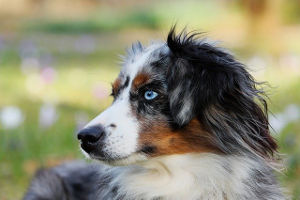
With parts of the country already setting record-high temperatures, many dog owners are tempted to take clippers to their canine companions. Before playing dog groomer, ask yourself how much you really know about your dog’s coat. While it may be long and appears hot and uncomfortable to you, that hair may be your dog’s best defense against the summer sun and heat.
Most veterinarians and professional groomers advise their clients against cutting a dog’s coat shorter than normal. There are several reasons for this. Many breeds have two coats, often referred to as a double coat or fur coat. On top, the coat is comprised of stiff guard hairs; beneath it are the down hairs of the undercoat. Breeds with a single coat, also known as a hair coat, have few, if any, down hairs. If your dog does not shed much, it may lack an undercoat. The topcoat not only shields dirt from working into the undercoat, but it also repels water. The undercoat provides much needed insulation for the animal. It naturally helps your pet stay warm in the winter. What many people don’t realize, however, is that it also helps prevent too much heat from working its way down through the hairs and against your pet’s body.
When a dog is shaved or trimmed so the hair is less than an inch long, the dog becomes vulnerable to heat, sunburn, insect bites, and cuts and scratches. As you can see, your pet may suffer more from other factors besides the summer heat. Further, if you are the one using the clippers, your inexperience may also cause harm. You could burn your pet, as clippers heat up very quickly. Worse, you may cut your dog’s skin. Dogs that have had their coat trimmed close to the skin may become prone to developing ingrown hairs. In some circumstances, though, a vet may recommend shaving or clipping. Dogs that develop hot spots or other skin conditions may feel better with a close shave. Long-haired dogs that predominately stay outdoors could also benefit. If they tend to get their coats wet frequently, they run the risk of contracting myiasis, which is the medical term for a maggot infestation.
Long-haired dogs or dogs that do not shed may need your help with keeping heat from being trapped in their undercoats. Unlike their owners, dogs cannot sweat. Besides dissipating heat through panting, they rely on cooling down by swimming or being sprayed with water, by catching a cool breeze, or by transferring their excess internal heat to a cool surface like a tile kitchen floor or cement floor of a garage. Water is not always the best option for dogs, though, because their coats can trap heat in if they become water-logged and hot after getting out of the water. Cool, wet towels wrapped around the dog can pose the same threat.
Avoiding over-exposure and over-exercising is key to a dog’s health in the summertime. Reconsider bringing the dog along on trips and events where finding a way to keep cool may be a challenge. This, of course, is not the season to be leaving any living creature inside a parked car! Keep your dog where it has constant access to cool, fresh water. If you notice excessive panting, your dog could be dehydrating. Brushing your pooch helps, too; it allows air to circulate to the skin better when the dead undercoat has been removed.
Finally, dog’s temperature tends to run about 101°F to 102°F. If your dog begins panting heavily or showing signs of confusion, poor coordination, or sluggishness, it could be over-heating. Watch out for the tongue or gums turning bright red, gray, or purple. These are signs of eminent danger resulting in fatality. Seek immediate help if your dog seems unable to cool down. Remember that you must think for your dog. No matter how hot it is, dogs will keep pushing their limits to please their owners.
